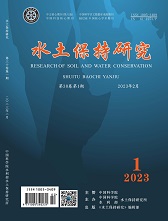[1]PENG Shun-lei,LIANG Ya-hong,CHEN Chang-dong,et al.Prediction of Soil Infiltration Capacity and Runoff under Different Restored Vegetation Types on the Eastern Side of Funiu Mountains[J].Research of Soil and Water Conservation,2013,20(04):29-33.
Copy
Prediction of Soil Infiltration Capacity and Runoff under Different Restored Vegetation Types on the Eastern Side of Funiu Mountains
Research of Soil and Water Conservation[ISSN 1005-3409/CN 61-1272/P] Volume:
20
Number of periods:
2013 04
Page number:
29-33
Column:
Public date:
2013-08-28
- Title:
- Prediction of Soil Infiltration Capacity and Runoff under Different Restored Vegetation Types on the Eastern Side of Funiu Mountains
- CLC:
- S152.7+2
- DOI:
- -
- Abstract:
- Aimed to test the effect of different restored vegetation types on soil infiltration capacity and runoff generation. Infiltration processes were measured with double-ring infiltration method in the six restored vegetation types on the eastern side of Funiu Mountains. The likelihood of runoff was inferred by comparing stable infiltration (Ks) at the top soil with prevailing storm intensities in the six restored vegetation types. The results indicated that: (1) the values of soil infiltration variables, including the initial infiltration, stable infiltration, and total amounts of infiltration before 60 minutes were in the sequences of Quercus variabilis secondary forest > Quercus variabilis plantation > Black Locust plantation > Platycladus orientalis plantation > Shrub > abandoned land; (2) soil bulk density, total porosity, non-capillary porosity, soil organic matter, fine root biomass, and water stable aggregate were significantly correlated with the variables of soil infiltration (p<0.05), soil bulk density and total porosity were the main factors affecting soil infiltration; (3) Quercus variabilis secondary forest could resist storm with 10 year recurrence, and Quercus variabilis plantation could overcome storm with 1 year recurrence. On the contrary, runoff was most likely to occur in the shrub land and abandoned land. It is suggested forest conversion and forest plantation with native tree species benefit for increasing soil infiltration capacity.
- References:
-
[1] 肖登攀,韩淑敏,杨艳敏,等.太行山低山丘陵区不同地表类型降雨入渗产流规律研究[J].水土保持研究,2009,16(5):35-39.
[2] 陈洪松,邵明安,张兴昌,等.野外模拟降雨条件下坡面降雨入渗、产流试验研究[J].水土保持学报,2005,19(2):5-8.
[3] Price K, Jackson C R, Parker A J. Variation of surficial soil hydraulic properties across land uses in the southern Blue Ridge Mountains, North Carolina, USA[J]. Journal of Hydrology,2010,383(3/4):256-268.
[4] Zimmermann B, Elsenbeer H. Spatial and temporal variability of soil saturated hydraulic conductivity in gradients of disturbance[J]. Journal of Hydrology,2008,361(1/2):78-95.
[5] 李玉山.黄土高原森林植被对陆地水循环影响的研究[J].自然资源学报,2001,16(5):427-432.
[6] 杨永辉,赵世伟,雷廷武,等.宁南黄土丘陵区不同植被下土壤入渗性能[J].应用生态学报,2008,19(5):1040-1045.
[7] 张治伟,朱章雄,王燕,等.岩溶坡地不同利用类型土壤入渗性能及其影响因素[J].农业工程学报,2010,26(6):71-76.
[8] 闫东锋,杨喜田.豫南山区典型林地土壤入渗特征及影响因素分析[J].中国水土保持科学,2011,9(6):43-50.
[9] 赵锦梅,张德罡,刘长仲.东祁连山土地利用方式对土壤持水能力和渗透性的影响[J].自然资源学报,2012,27(3):422-429.
[10] 刘洁,李贤伟,纪中华,等.元谋干热河谷三种植被恢复模式土壤贮水及入渗特性[J].生态学报,2011,31(8):2331-2340.
[11] Hassler S K, Zimmermann B, van Breugel M, et al. Recovery of saturated hydraulic conductivity under secondary succession on former pasture in the humid tropics[J]. Forest Ecology and Management,2011,261(5):1634-1642.
[12] 杨三平,李志华.鲁山县荒山治理开发模式及成效[J].中国水土保持,2006(12):54-54.
[13] Ren L, Lai J. Assessing the size dependency of measured hydraulic conductivity using double-ring infiltrometers and numerical simulation[J]. Soil Science Society of America Journal,2007,71(6):1667-1675.
[14] Li Y Y, Shao M A. Change of soil physical properties under long-term natural vegetation restoration in the Loess Plateau of China[J]. Journal of Arid Environments,2006,64(1):77-96.
[15] Silver W L, Thompson A W, McGroddy M E, et al. Fine root dynamics and trace gas fluxes in two lowland tropical forest soils[J]. Global Change Biology,2005,11(2):290-306.
[16] 邵明安,王全九,黄明斌.土壤物理学[M].北京:高等教育出版社,2006:126-128.
[17] 李卓,吴普特,冯浩,等.容重对土壤水分入渗能力影响模拟试验[J].农业工程学报,2009,25(6):40-45.
[18] 彭亿,李裕元,李忠武,等.红壤坡地生态系统土壤入渗特征比较研究[J].水土保持研究,2009,16(6):205-209.
[19] 刘建立,王彦辉,程丽莉,等.六盘山北侧不同立地土壤的蓄水性能和渗透性研究[J].水土保持研究,2009,16(3):61-64.
[20] 喻明美,谢正生.广州市白云山五种森林类型的土壤渗透性研究[J].水土保持研究,2011,18(1):153-156.
- Similar References:
Memo
-
Last Update:
1900-01-01
